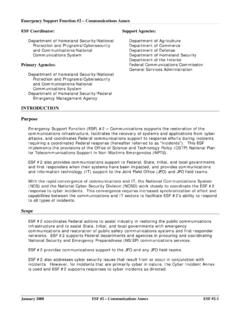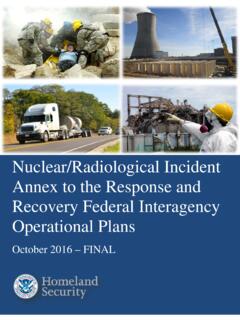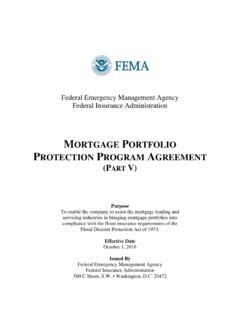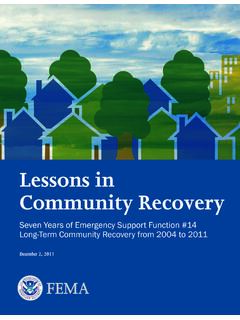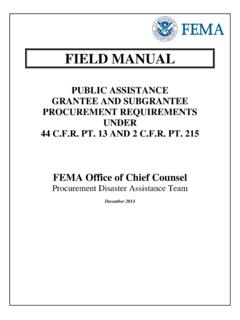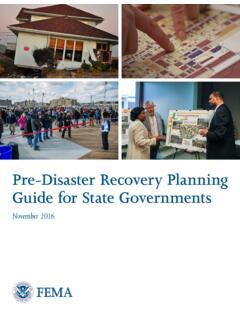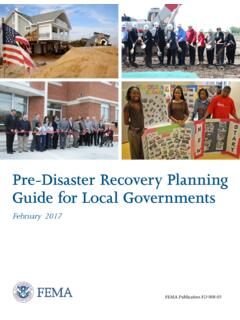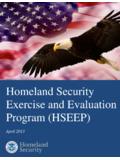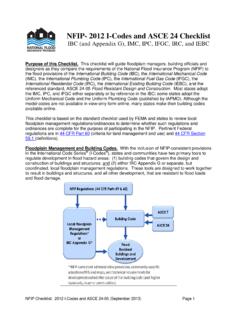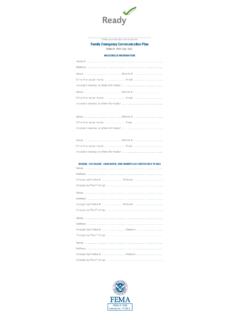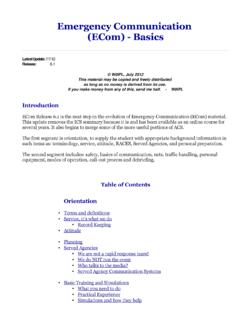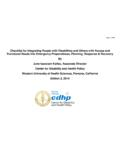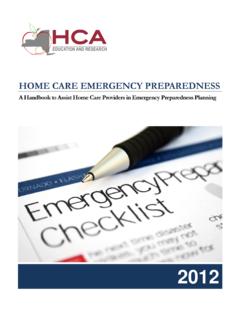Transcription of Create Your Family Emergency Communication Plan
1 BE SMART. TAKE PART. Create YOUR Family . Emergency . Communication plan . Join with others to prepare for emergencies and participate in America's PrepareAthon! | Creating your Family Emergency Communication plan starts with one simple question: What if? . What if something happens and I'm not with my Family ? Will I be able to reach them? How will I know they are safe? How can I let them know I'm OK? During a disaster, you will need to send and receive information from your Family . Communication networks, such as mobile phones and computers, could be unreliable during disasters, and electricity could be disrupted. Planning in advance will help ensure that all the members of your household including children and people with disabilities and others with access and functional needs, as well as outside caregivers know how to reach each other and where to meet up in an Emergency . Planning starts with three easy steps: 1. COLLECT. Create a paper copy of the contact information for your Family and other important people/offices, such as medical facilities, doctors, schools, or service providers.
2 2. SHARE. Make sure everyone carries a copy in his or her backpack, purse, or wallet. If you complete your Family Emergency Communication plan online at , you can print it onto a wallet-sized card. You should also post a copy in a central location in your home, such as your refrigerator or Family bulletin board. 3. PRACTICE. Have regular household meetings to review and practice your plan . If you are using a mobile phone, a text message may get TEXT through when a phone call will not. This is because a text IS message requires far less bandwidth than a phone call. Text BEST! messages may also save and then send automatically as soon as capacity becomes available. July 2015. The following sections will guide you through the process to Create and practice your Family Emergency Communication plan . HOUSEHOLD INFORMATION. Write down phone numbers and email addresses for everyone in your household. Having this important information written down will help you reconnect with others CO LLE C T.
3 In case you don't have your mobile device or computer with you or if the battery runs down. If you have a household member(s) who is Deaf or hard of hearing, or INFORMATION who has a speech disability and uses traditional or video relay service (VRS), include information on how to connect through relay services on a landline phone, mobile device, or computer. SCHOOL, CHILDCARE, CAREGIVER, AND WORKPLACE. Emergency PLANS. Because a disaster can strike during school or work hours, you need to know their Emergency response plans and how to stay informed. Discuss these plans with children, and let them know who could pick them up in an Emergency . Make sure your household members with phones are signed up for alerts and warnings from their school, workplace, and/or local government. To find out more about how to sign up, see Be Smart. Know Your Alerts and Warnings at For children without mobile phones, make sure they know to follow instructions from a responsible adult, such as a teacher or principal.
4 OUT-OF-TOWN CONTACT. It is also important to identify someone outside of your community or State who can act as a central point of contact to help your household reconnect. In a disaster, it may be easier to make a long-distance phone call than to call across town because local phone lines can be jammed. Emergency MEETING PLACES. Decide on safe, familiar places where your Family can go for protection or to reunite. Make sure these locations are accessible for household members with disabilities or access and functional needs. If you have pets or service animals, think about animal-friendly locations. Identify the following places: Indoor: If you live in an area where tornadoes, hurricanes, or other high-wind storms can happen, make sure everyone knows where to go for protection. America's PrepareAthon! This could be a small, interior, windowless room, such as a closet or bathroom, on the lowest level of a sturdy building, or a tornado safe room or storm shelter.
5 In your neighborhood: This is a place in your neighborhood where your household members will meet if there is a fire or other Emergency and you need to leave your home. The meeting place could be a big tree, a mailbox at the end of the driveway, or a neighbor's house. Outside of your neighborhood: This is a place where your Family will meet if a disaster happens when you're not at home and you can't get back to your home. This could be a library, community center, house of worship, or Family friend's home. 2. Outside of your town or city: Having an out-of-town meeting place can help you reunite if a disaster happens and: You cannot get home or to your out-of-neighborhood meeting place; or Your Family is not together and your community is instructed to evacuate the area. This meeting place could be the home of a relative or Family friend. Make sure everyone knows the address of the meeting place and discuss ways you would get there. OTHER IMPORTANT NUMBERS AND INFORMATION.
6 You should also write down phone numbers for Emergency services, utilities, service providers, medical providers, veterinarians, insurance companies, and other services. Make copies of your Family Emergency Communication plan for each member of the household to carry in his or her wallet, backpack, or purse. Post a copy in a central place at home. Regularly check to make sure your household SHARE. members are carrying their plan with them. Enter household and Emergency contact information into all household MAKE SURE members' mobile phones or devices. EVERYONE HAS. THE INFORMATION Store at least one Emergency contact under the name In Case of Emergency . or ICE for all mobile phones and devices. This will help someone identify your Emergency contact if needed. Inform your Emergency contact of any medical issues or other requirements you may have. Create a group list on all mobile phones and devices of the people you would need to communicate with if there was an Emergency or disaster.
7 Make sure all household members and your out-of-town contact know how to text if they have a mobile phone or device, or know alternative ways to communicate if they are unable to text. Read Be Smart. Know Your Alerts and Warnings at and sign up to receive Emergency information. America's PrepareAthon! Once you have completed your Family Emergency Communication plan , made copies for all the members of your household, and discussed it, it's time to practice! Here are some ideas for practicing your plan : Practice texting and calling. Have each person practice sending a text message NOW IT'S TIME TO. PRACTICE! or calling your out-of-town contact and sending a group text to your mobile phone group list. Discuss what information you should send by text. You will want to let others know you are safe and where you are. Short messages like I'm OK. At library . are good. 3. Talk about who will be the lead person to send out information about the designated meeting place for the household.
8 Practice gathering all household members at your indoor and neighborhood Emergency meeting places. Talk about how each person would get to the identified out-of-neighborhood and out-of-town meeting places. Discuss all modes of transportation, such as public transportation, rail, and para-transit for all Family members, including people with disabilities and others with access and functional needs. Regularly have conversations with household members and friends about the plan , such as whom and how to text or call, and where to go. To show why it's important to keep phone numbers written down, challenge your household members to recite important phone numbers from memory . now ask them to think about doing this in the event of an Emergency . Make sure everyone, including children, knows how and when to call 911 for help. You should only call 911 when there is a life-threatening Emergency . Review, update, and practice your Family Emergency Communication plan at least once a year, or whenever any of your information changes.
9 To help start the conversation or remind your Family why you are taking steps to prepare and practice, you may want to watch the 4-minute video, It Started Like Any Other Day, about families who have experienced disaster, at Click on the closed captioning (CC). icon on the lower right to turn on the captioning. After you practice, talk about how it went. What worked well? What can be improved? What information, if any, needs to be updated? If you make updates, remember to print new copies of the plan for everyone. OTHER IMPORTANT TIPS FOR COMMUNICATING IN DISASTERS 1. Text is best when using a mobile phone, but if you make a phone call, keep it brief and convey only vital information to Emergency personnel and/or Family or household members. This will minimize network congestion, free up space on the network for Emergency communications, and conserve battery power. Wait 10 seconds before redialing a number. If you redial too quickly, the data from the handset to the cell sites do not have enough time to clear before you've re-sent the same data.
10 This contributes to a clogged network. Conserve your mobile phone battery by reducing the brightness of your screen, placing your phone in airplane mode, and closing apps you do not need. Limit watching videos and playing video games to help reduce network congestion. Keep charged batteries, a car phone charger, and a solar charger available for backup power for your mobile phone, teletypewriters (TTYs), amplified phones, and caption phones. If you charge your phone in your car, be sure the car is in a well-ventilated area ( , not in a closed garage) to avoid life-threatening carbon monoxide poisoning. 1. Federal Communications Commission, Public Safety and Homeland Security Bureau. ( ) Tips for communicating 4 in an Emergency . Retrieved from If driving, do not text, read texts, or make a call without a hands-free device. Maintain a household landline and analog phone (with battery backup if it has a cordless receiver) that can be used when mobile phone service is unavailable.
